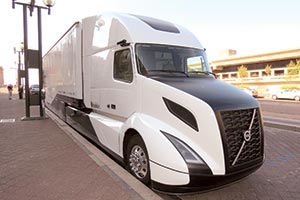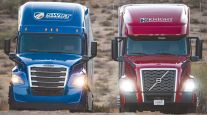Volvo Unveils SuperTruck at DOE, Joins Stage 2 of Research Project

This story appears in the Sept. 19 print edition of Transport Topics.
WASHINGTON — Volvo Trucks North America unveiled its version of SuperTruck for inspection by Energy Secretary Ernest Moniz, with the modified VNL 670 highway tractor demonstrating an 88% gain in freight efficiency and an extra 70% in fuel economy.
“It is a special day for us because today we are going to unveil the Volvo SuperTruck for the first time. It’s a milestone in our history, and I think we are all proud to be able to communicate in a good way the findings we have with this project,” VTNA President Göran Nyberg said Sept. 13.
The Class 8, with top-of-cab solar panels powering its battery and interior lights, cameras that replace side mirrors, hidden steps, and a 425 horsepower, 11-liter proprietary engine, is VTNA’s entry in the U.S. Department of Energy’s original SuperTruck research program.
“We are very excited about the SuperTruck initiative because of the impact in terms of fuel economy and emissions,” Moniz said. “That’s important for the United States, but this has garnered a tremendous amount of international attention as well.”
Even as it showed off the vehicle, the manufacturer said it is planning to continue that work under the new SuperTruck II initiative. VTNA, which received $19 million from DOE under the original program, has been selected to receive an additional $20 million for SuperTruck II.
DOE spends the money, which must be matched dollar for dollar by original equipment manufacturers, to accelerate the development of heavy-duty trucks that are more fuel-efficient, thereby conserving energy and reducing diesel emissions.
Moniz, who knew that 81% of U.S. freight, as measured by revenue, travels on trucks, said doubling fuel efficiency “is a big deal.”
“It’s great to see the actual physical object that embodies all of these technologies and to hear how some of them are already coming into 2017 models,” he said.
Although the most complex systems, such as waste-heat recovery, “are going to take longer to become part of the commercial offering,” they can serve as “a set of technology lessons incorporated with time as the costs come down,” Moniz said.
Nyberg led Moniz on the inspection tour, along with several of the manufacturer’s engineers.
“This is a knowledge accelerator,” Nyberg said of the SuperTruck during a press briefing prior to the DOE event. “We wanted to see how we could take learnings from the project and deliver them to our customers to advance productivity and fuel efficiency.”
He said the research produced a 6.5% increase in fuel efficiency through powertrain optimiza- tion and an additional 3.5% gain through better aerodynamics.
Using a 2009 Volvo as a baseline, miles per gallon rose to 12, on average, from 7 mpg. By changing some steel components to aluminum and introducing carbon-fiber materials, the Volvo SuperTruck dropped 3,200 pounds in net weight, helping to increase freight efficiency — ton-miles traveled per gallon of fuel used — by 88% over the baseline.
The DOE grant, which must be funded by Congress to become official, calls for the company to increase fuel efficiency by using alternative engine designs and lightweight tractor-trailers.
The research program coincides with federal regulation of greenhouse-gas emissions of heavy- and medium-duty trucks by the Environmental Protection Agency and the National Highway Traffic Safety Administration.
Nyberg said VTNA’s 2017 powertrains, which comply with Phase 1 of GHG rules, include several components that were developed as part of SuperTruck; specifically, wave pistons that minimize unburned fuel; a common-rail, fuel-injection system; and turbo compounding, an elementary form of waste-heat recovery.
In August, EPA and NHTSA released their final version of Phase 2 of GHG regulation, a rule that will tighten emission standards on trucks in 2021, 2024 and 2027. More technology developed in SuperTruck and SuperTruck II will help VTNA meet those standards, Nyberg said, but he declined to specify which innovations are closest to introduction.
“There’s enough meat on this,” Nyberg said of the research results.
Four original equipment manufacturers are participating in both SuperTruck programs: Volvo, Daimler Trucks North America’s Freightliner unit, Navistar Inc. and a joint deal between Peterbilt Motors Co. and Cummins Inc. Peterbilt is a unit of Paccar Inc.
Freightliner and Peterbilt-Cummins already have showcased their SuperTruck results, and Navistar is close to demonstrating a vehicle, according to a DOE statement and a company spokeswoman.
Since its launch in 2010, the SuperTruck program has had two statistical goals — increase freight efficiency by 50% over a 2009 baseline for the first SuperTruck and by 100% over the same base for SuperTruck II.
Having hit 88% in the original program, Volvo’s 100% goal for SuperTruck II could be easily within reach.
The program also looks at brake thermal efficiency, or the actual work done by an engine as a percentage of the theoretical potential for work found in the engine’s fuel.
Volvo hit its goal of 50% for brake thermal efficiency, and for SuperTruck II the challenge rises to 55% brake thermal efficiency. The baseline efficiency level in 2009 was 42%.
While the first SuperTruck program focused on linehaul applications, SuperTruck II will offer more for regional applications, VTNA Senior Vice President Susan Alt said.
Volvo will work with truckload carrier Knight Transportation and grocery chain Wegman’s Food Markets to test new systems for SuperTruck II.




